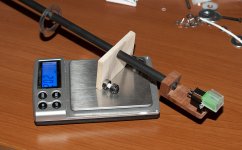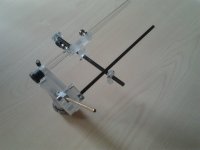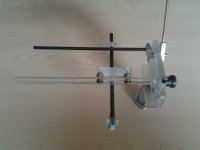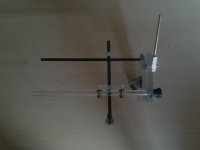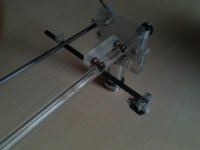I just finished my test carriage. Including a rough counterweight and an audiotechnica AT95e it is 20.2grams in total.

The square thingy is made out of 50x35x5mm maple, and I could easily make it lighter by using mahogany and cutting the edges to make it a T.
I just had the maple piece already cut to thickness and I was bored to get my miter saw out.
The headshell can also be easily made lighter by making it like the one Colin uses. Meaning cutting the plank thingy and just keeping the base more or less.
About the bearings and the threads, I do not have any brass tubing, and to be honest I cannot justify using it anyway. I know I should trust Colin by now, but it is defeating the whole purpose of using a bearing. If we want double bearing we should use that. Two bearings one inside the other (if we find a way to keep them in place...).
In any case, I have used M4 threads with alen heads. Their threaded part fits nicely through the bearings, but it still had some play, so I used a thin layer of teflon tape. The bearings are now nice and snug on the threads, and I have placed them so that they do not touch either the wood or the screw head. They are not very tight, just snug enough to require some finger force to move on the thread.
Unfortunately I could not find a glass tube so far and the SKF axles were too expensive, so I am making some preliminary tests with a 10mm plexi tube I had laying around.
What I have noticed is that the bearings do not always roll. They slide/rub on the surface of the tube. If I apply some more weight with my hand, they seem to roll just fine.
I had to put some black marker spots on the bearings to notice this.
Have you guys noticed something similar?
My bearings are SKF 4x9x4 closed ones and I have not used any lubrication on them.
The square thingy is made out of 50x35x5mm maple, and I could easily make it lighter by using mahogany and cutting the edges to make it a T.
I just had the maple piece already cut to thickness and I was bored to get my miter saw out.
The headshell can also be easily made lighter by making it like the one Colin uses. Meaning cutting the plank thingy and just keeping the base more or less.
About the bearings and the threads, I do not have any brass tubing, and to be honest I cannot justify using it anyway. I know I should trust Colin by now, but it is defeating the whole purpose of using a bearing. If we want double bearing we should use that. Two bearings one inside the other (if we find a way to keep them in place...).
In any case, I have used M4 threads with alen heads. Their threaded part fits nicely through the bearings, but it still had some play, so I used a thin layer of teflon tape. The bearings are now nice and snug on the threads, and I have placed them so that they do not touch either the wood or the screw head. They are not very tight, just snug enough to require some finger force to move on the thread.
Unfortunately I could not find a glass tube so far and the SKF axles were too expensive, so I am making some preliminary tests with a 10mm plexi tube I had laying around.
What I have noticed is that the bearings do not always roll. They slide/rub on the surface of the tube. If I apply some more weight with my hand, they seem to roll just fine.
I had to put some black marker spots on the bearings to notice this.
Have you guys noticed something similar?
My bearings are SKF 4x9x4 closed ones and I have not used any lubrication on them.
Attachments
Last edited:
Did some more testing...
It seems that which-ever way the carriage moves, different bearings move.
If I move the carriage to the right, I get rolling on the right front and the left back bearings. and the opposite when I move it to the left.
I guess it s because I am testing it by hand. And perhaps I need to play with the bearing distance a bit, currently being 4.3mm
It seems that which-ever way the carriage moves, different bearings move.
If I move the carriage to the right, I get rolling on the right front and the left back bearings. and the opposite when I move it to the left.
I guess it s because I am testing it by hand. And perhaps I need to play with the bearing distance a bit, currently being 4.3mm
Did some more testing...
It seems that which-ever way the carriage moves, different bearings move.
If I move the carriage to the right, I get rolling on the right front and the left back bearings. and the opposite when I move it to the left.
I guess it s because I am testing it by hand. And perhaps I need to play with the bearing distance a bit, currently being 4.3mm
Hi Dimitris ,
Seems that either you'r sliding tube has some deformation , or too much bearing friction for some reason
I'd try to get a glass tube first ... should be a labatory glass supplier in Athens ?? search the web for this as there must be one in such a large city .
BTW .. I like your headshells
Paul
It s weird...
I am designing something else now but it s too late here to work my drill press. I ll show you guys tomorrow.
BTW Paul I also love that design of headshell. Looks very pro
But besides that, in a design like this where minimum weight is a requirement, there is really no reason to create something like that.... You could lose about 3cm of wood and replace it with extra length in the carbon wand. You would just have to put the arm's pivot higher...
Anyway, if I only manage to find an easy way to add screw rails to them... I m thinking something like a guide for the drill press or something... we ll see
I am designing something else now but it s too late here to work my drill press. I ll show you guys tomorrow.
BTW Paul I also love that design of headshell. Looks very pro
But besides that, in a design like this where minimum weight is a requirement, there is really no reason to create something like that.... You could lose about 3cm of wood and replace it with extra length in the carbon wand. You would just have to put the arm's pivot higher...
Anyway, if I only manage to find an easy way to add screw rails to them... I m thinking something like a guide for the drill press or something... we ll see
I just finished my test carriage. Including a rough counterweight and an audiotechnica AT95e it is 20.2grams in total.

The square thingy is made out of 50x35x5mm maple, and I could easily make it lighter by using mahogany and cutting the edges to make it a T.
I just had the maple piece already cut to thickness and I was bored to get my miter saw out.
The headshell can also be easily made lighter by making it like the one Colin uses. Meaning cutting the plank thingy and just keeping the base more or less.
About the bearings and the threads, I do not have any brass tubing, and to be honest I cannot justify using it anyway. I know I should trust Colin by now, but it is defeating the whole purpose of using a bearing. If we want double bearing we should use that. Two bearings one inside the other (if we find a way to keep them in place...).
In any case, I have used M4 threads with alen heads. Their threaded part fits nicely through the bearings, but it still had some play, so I used a thin layer of teflon tape. The bearings are now nice and snug on the threads, and I have placed them so that they do not touch either the wood or the screw head. They are not very tight, just snug enough to require some finger force to move on the thread.
Unfortunately I could not find a glass tube so far and the SKF axles were too expensive, so I am making some preliminary tests with a 10mm plexi tube I had laying around.
What I have noticed is that the bearings do not always roll. They slide/rub on the surface of the tube. If I apply some more weight with my hand, they seem to roll just fine.
I had to put some black marker spots on the bearings to notice this.
Have you guys noticed something similar?
My bearings are SKF 4x9x4 closed ones and I have not used any lubrication on them.
Hi Dimkasta,
Looks like you are off to a good start. Sorry your bearings are reluctantly rolling. For starters I suggest removing entirely the teflon tape. You do not want the bearings to be nice and snug in this application. If you really want to have the bearings supported by screw threads put the screws in an electric drill or a lathe and stone and polish the high peaks off the threads. Not much, just enough to smooth the sharp points off the threads.Then try your test again. Then test the rolling of the outer cages relative to the inner cages to determine their ability to move freely and smoothly without any perceptible drag. Just because you have not used any lubrication doesn't mean SKF didn't. Bearings can be shipped out with lubrication ranging from none to very light oil to literally grease. They won't roll if they have grease
in them and earlier in this topic it was pointed out that they didn't work well at all if used dry. In ball bearings the balls are kept uniformly positioned and not bumping into one another by a loose fitting pressed metal cage. Lubricant can be difficult to remove from the cage. So flush them out well (many times), dry them and apply only a tiny drop of light oil in the space between the inner and outer races. Use something like #5 oil, clock oil or watch oil and run them in by hand to distribute the oil. You have no idea what SKF supplied. Do it so you know what you have. Then even if you still need to use the plexi tube use a counterweight on the back end of a test arm to balance the whole thing and tip one end of the tube down to let gravity supply the motive force to run the carriage. Also observe that with the loose fitting bearings all four of the are uniformly contacting the tube. And find some glass tube, any glass tube to use for testing. You may get away with plexi so give it a shot. Please let us know what you have done and the results.
Regards,
BillG
Last edited:
hope this will help you
SCHOTT worldwide - Offices and production facilities | SCHOTT AG
Hi Dimitris , check out these guys in Athens .. they both are official Duran glass tube distributors and
I bet they have some in stock .
Paul
SCHOTT worldwide - Offices and production facilities | SCHOTT AG
Hi Dimitris , check out these guys in Athens .. they both are official Duran glass tube distributors and
I bet they have some in stock .
Paul
Last edited:
SO FAR , SO GOOD
Well ... looks as I can have it installed on my mass TT plinth pretty soon
I want a support for the signal wiring too , somewhere halve way the wand
travelling ( grooved record surface ) and some kind of loop too have it going
as easy as reasonable possible .. my gosh ... another challenge at this point haha .. nothing for free I guess
Give the guys a call , Dimitris .. I got mine within a mile from my living place
too .. never expected them to be that close too
Paul
Well ... looks as I can have it installed on my mass TT plinth pretty soon
I want a support for the signal wiring too , somewhere halve way the wand
travelling ( grooved record surface ) and some kind of loop too have it going
as easy as reasonable possible .. my gosh ... another challenge at this point haha .. nothing for free I guess
Give the guys a call , Dimitris .. I got mine within a mile from my living place
too .. never expected them to be that close too
Paul
Attachments
Nice work Paul, it looks awesome!: Dimkasta, it's your choice to trust my judgement or not, but when used as designed provides failure free service, and friction so low that a small angle on the tube will let there arm slide effortlessly. With the tolerances
of the brass vs bearing with some quick.studying you will see just why it works the way it does .
.
Colin
of the brass vs bearing with some quick.studying you will see just why it works the way it does
Colin
SCHOTT worldwide - Offices and production facilities | SCHOTT AG
Hi Dimitris , check out these guys in Athens .. they both are official Duran glass tube distributors and
I bet they have some in stock .
Paul
Hi and thanks for the link Paul

Which of all the products should I choose as there were quite a lot of them?
Brgds
Well ... looks as I can have it installed on my mass TT plinth pretty soon
I want a support for the signal wiring too , somewhere halve way the wand
travelling ( grooved record surface ) and some kind of loop too have it going
as easy as reasonable possible .. my gosh ... another challenge at this point haha .. nothing for free I guess
Give the guys a call , Dimitris .. I got mine within a mile from my living place
too .. never expected them to be that close too
Paul
Hi Paul,
would you mind sharing some pic of the arm holder? It seems very well done, and also easy to set up!
Your build is a truly inspiration!
Ciao.
Marco
Hi and thanks for the link Paul
Which of all the products should I choose as there were quite a lot of them?
Brgds
Found DURAN
Brgds
SCHOTT worldwide - Offices and production facilities | SCHOTT AG
Hi Dimitris , check out these guys in Athens .. they both are official Duran glass tube distributors and
I bet they have some in stock .
Paul
Pffff... none of them have tubes... FFS... damn crisis...
- Home
- Source & Line
- Analogue Source
- DIY linear tonearm
